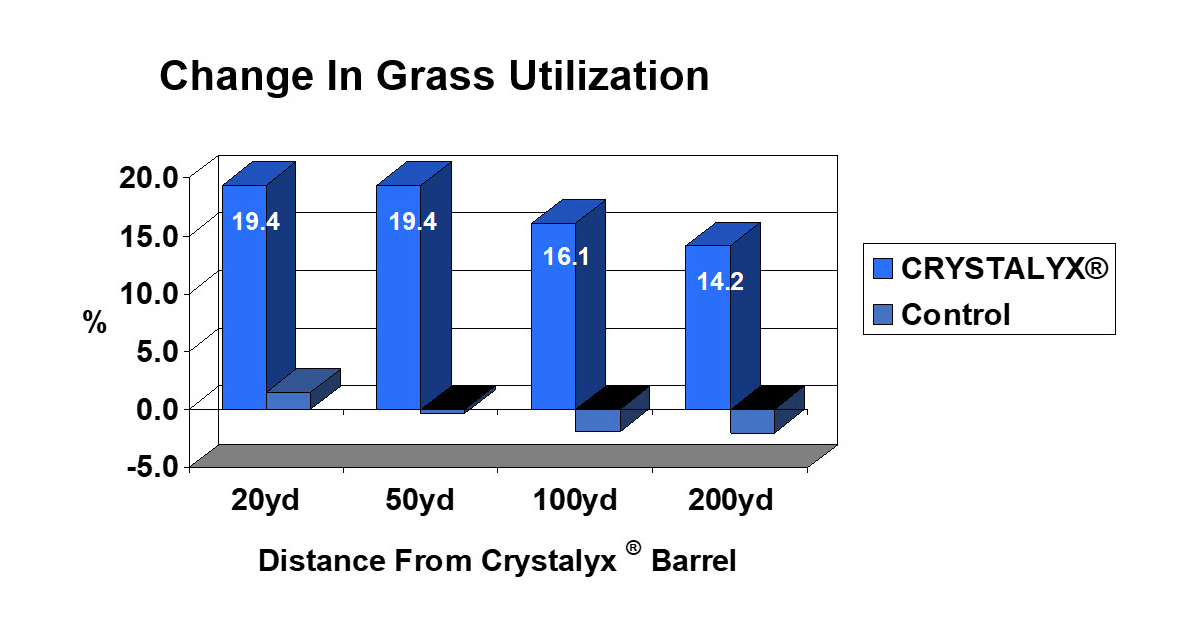Grazing management is a collective term for managing even grazing in cattle for more efficient utilization of the forage available. Part of the practice of grazing management includes protecting and enhancing riparian areas and watershed to support wildlife and recreational uses of the land. Given the choice, cattle will take the easiest route and graze near shade and water, leaving other areas underutilized, which reduces the overall caring capacity and health of the whole pasture. The strategic placement of CRYSTALYX® supplements, however, can help move your cattle to areas that have experienced less grazing.

The specific best-management practices for both your cattle and your grazing system will vary depending on your geography. In the mountain ranges of the western United States, this can include large tracts — often thousands of acres — of private and public grazing lands. Finding a way to get cattle to graze the highland and rougher terrain, instead of spending all their time in lowland riparian areas, can be challenging. Furthermore, herding cattle on horseback and adding/maintaining fencing can be both expensive and time-consuming. In the midwestern states, pastures are often hilly, and many narrow, oddly-shaped pastures snake alongside waterways. Most of the ground in that region is utilized for corn and soybeans. The soil quality and generally adequate levels of moisture make for ample forage growth, but it can be challenging to keep cattle moving across the whole pasture to consume the older, more mature grass. Finally, the southeastern states feature big pastures with abundant water sources, but they must also deal with the added risk of under-grazed areas returning to shrub growth.
---------------------------------------------------------------------------------------------------------
RELATED: Grazing management technology moves into the robotic dairy barn
---------------------------------------------------------------------------------------------------------
Strategically placing CRYSTALYX self-fed supplements can modify cow movement
New data from the dairy industry supports the findings of other CRYSTALYX beef cattle research conducted in the 1990s and early 2000s. In field trials, the placement of CRYSTALYX near the robot milking center increased the number of cow visits to the robot. For many years, the dairy industry has utilized RFID tags to record milk production in the parlor and pedometers to track estrus activity. The next generation of animal tracking on a dairy, however, is geo-tracking an animal’s location in a facility, narrowed down to a matter of feet. This tracking is live and is recorded for 24 hours a day. The University of Kentucky Coldstream Dairy already has the capability to do this, as is illustrated in Figure 1, which shows the location of each individual cow.
Figure 1. University of Kentucky SMARTBOW Animal Tracking System
Recently, we conducted a trial to document the dairy cow visits to a CRYSTALYX supplement using this system. The data was verified by human observation. The herd was divided into two groups: a control group and a treatment group. Barrels were placed at the ends of the loafing area, which is not regularly visited by the cattle. The treatment animals were switched once for each pen. Our results were very similar to the grazing research conducted by Dr. Derek Bailey at New Mexico State University and Montana State University.

The cows visited the barrel an average of 2.01 times per day — which is in line with the 2.18 visits per day seen in Dr. Bailey’s beef pasture trial. Both trials also saw a high percentage of cows visit the barrels each day: 92 percent in the UK study and 86–97 percent in the research conducted by Dr. Bailey. Our trial was also able to confirm an average of 16.49 minutes per day spent at the barrel. This new dairy data supports the idea that we can alter cattle movement by using CRYSTALYX as a grazing management tool.
Grazing management research has shown a 15- to 25-percent improvement in forage utilization, and this improvement extends as far away as 0.3–0.5 miles from the supplement. Knowing that cattle will follow the barrels can be used as a tool for success in your grazing management plan.


CRYSTALYX offers a wide variety of mineral products that can be utilized on pasture, which can mean decreased labor and equipment costs. In addition, by both modifying grazing distribution and providing consistent mineral delivery, you get a “two-for-one” deal. Mark Robbins’ recent blog about summer mineral supplements serves as an excellent review of the mineral options available. To learn more, visit your local CRYSTALYX dealer.

